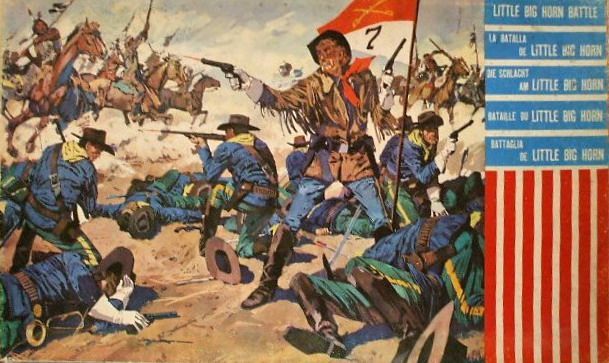The Battle of the Little Big Horn (1962) Board Game
The Battle of the Little Bighorn, also known as Custer’s Last Stand, was a famous battle in American history that took place in 1876 between the US Army’s 7th Cavalry Regiment and a combined force of Lakota, Northern Cheyenne, and Arapaho tribes. The battle resulted in a victory for the Native American forces led by Sitting Bull and Crazy Horse, and the death of General George Armstrong Custer.
Game Components of The Battle of the Little Big Horn
– Game board featuring a battleground map
– Plastic figures including:
– General Custer
– Two officers
– Six men of the 7th Cavalry
– Regimental flag
– Three mounted Indian chiefs
– Three mounted Tomahawk-armed Indians
– Six Indian warriors with rifles
– Terrain features like trees, boulders, and battlements
– Dice for resolving combat.
How To Setup The Battle of the Little Big Horn
To set up the game, each player prepares their forces on designated starting positions on the board. The US Cavalry units, including Custer, his officers, and the regimental flag, are placed on one side of the board. The Native American forces, including the mounted chiefs and warriors, are placed on the other side. The board includes specific terrain features and restrictions, such as areas where mounted Indians cannot enter or pass over, and designated crossing points for the river.
Gameplay Mechanics and Game Objective
– Dice rolling for combat resolution
– Unit movement and positioning
– Terrain effects on movement and combat
Player Experience
Players who have experienced this game often reminisce about its simplicity and strategic depth. The game appealed to both wargamers and non-wargamers due to its straightforward rules and engaging gameplay. Players developed various strategies, such as focusing on eliminating key units or capturing the flag, which added to the game’s replay value.
Pros
Cons
Personal Thoughts on The Battle of the Little Big Horn
This game is ideal for those who enjoy historical wargames and are looking for a straightforward, yet engaging, gaming experience. It is particularly suited for collectors of vintage board games and those nostalgic for games from the 1960s. While it may not offer the complexity of modern wargames, it provides a fun and tactical experience that can be enjoyed by both casual and seasoned gamers.
We are supported by our audience. When you purchase through links on our site, we may earn an affiliate commission, at no extra cost for you. Learn more.

